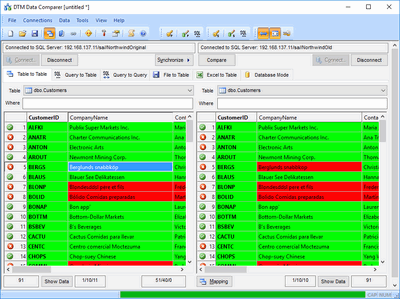How to compare and synchronize MySQL databases with DTM Data Comparer?
DTM Data Comparer is a data comparison and synchronization software. It was designed and developed to help database users to compare or synchronize MySQL databases and other database types. The tool offers both visual and console (unattended) modes of comparison and synchronization. All modern versions of MySQL Servers are supported: DTM Data Comparer uses unified interface (ODBC or OLE DB) to access data rows.
The software fetches MySQL tables and compares primary key values. Of course, the user allowed defining alternate unique key if the table has no PK. If the table has no rows with the same key value, the software places the records to different data grid lines and marks row by the yellow background. If the key values are equal the program places them to the same grid lines and marks cells for equal fields by green background and different fields by red.
The important DTM Data Comparer feature is tables with different structure comparison: mapping allows users to assign correspondence between source and target columns. The user can also apply built-in database functions like CAST to destination value. It is suitable for complex comparison for different data types.
Download free demo version
Key Product's Features
- The software can compare tables in two MySQL Server tables as well as to compare MySQL table with another data format like DB2 or text file.
- It supports a lot of tuning options and synchronization modes: append only, delete only, remove only, etc.
- DTM Data Comparer is able to operate with whole databases as well as compare MySQL tables pair.
- Query to Table mode is suitable for complex cases like join of tables comparison without a temporary view.
- For wide and large scale MySQL tables the software offers special navigation modes.
- The built-in "Face to face" viewer is suitable for wide tables comparison.
Why DTM Data Comparer is suitable for MySQL
- It understands and correct recognizes MySQL-specific data types: mediumint, mediumtext, tinyblob, mediumblob, longtext, etc.
- $DATE$ and $TIME$ macros helps to create a set of continuous reports automatically.
- In can help to liken MySQL data with another type of database: Oracle, DB2, Informix, etc.
